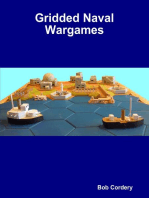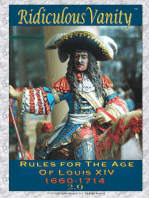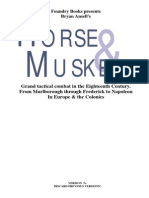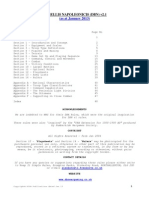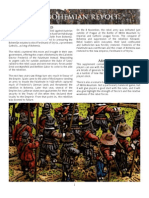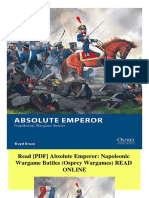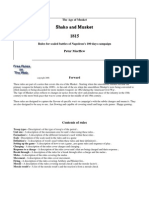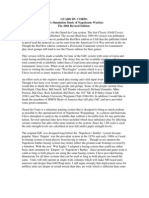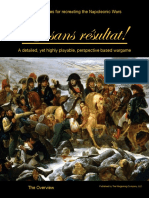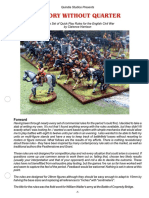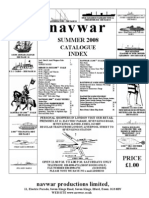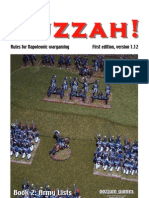Dba-Hx3 0
Dba-Hx3 0
Uploaded by
Marc TemplerCopyright:
Available Formats
Dba-Hx3 0
Dba-Hx3 0
Uploaded by
Marc TemplerOriginal Description:
Original Title
Copyright
Available Formats
Share this document
Did you find this document useful?
Is this content inappropriate?
Copyright:
Available Formats
Dba-Hx3 0
Dba-Hx3 0
Uploaded by
Marc TemplerCopyright:
Available Formats
DBA-HX 3.
0 1700 1850
Using the latest version DBA 3.0 players can fight battles from the Spanish Succession to the overseas
conflicts prior to the Indian Mutiny. This includes a core set of rules with amendments for the Seven Years
War, the Napoleonic Era and Early Colonial battles and Army Lists. You do need DBA 3.0 to use.
Robert Madrigal (a.k.a. Timurilank), 21-02-2015
pag. 1
DBA-HX 3.0 1700 1850
The DBA Humberside extension used DBA 1.1 allowing players to re-fight battles from the Pike and Shot
era to the late 19th century (1500 1900). As DBA-RRR handles the Shot and Pike era, this variant starts
from the 18th century and ends before the general use of rifled muskets (1700 1850). You will need DBA
3.0 to make use of this variant.
Ground scale, distance measurement, time scale (page 2) and Historical refights (page 14)
Scale and measurements remain consistent with the basic rule set (DBA 3.0) as do army representation
where each element represents 1/12 of an army led by a general. Re-fighting historical battles, we
recommend the guidelines as specified on page 14. An element of foot or horse as 500 600 troops, 1,000 +
horde, 250 300 horse or camel riders and an artillery model represents 6-8 pieces. 1BW equals 80 paces.
Troop Descriptions
Cuirassier
The term describes those heavy cavalry that made use of breastplate and helm and includes elite
formations as the Maison du Roi, Horse Grenadier, and Guard units.
Cavalry
The majority of battlefield cavalry to include Dragoon and Prussian Hussar of the Seven Years War. The
term also describes irregular formations armed with a variety of melee weapons and firearms.
Lancer
Battlefield cavalry primarily armed with the lance. These appear mainly on the army lists of the Napoleonic
era and later.
Light Horse
Describes irregular formations that skirmished using bow, firearms or spear in combat. Hussars of the
Spanish Succession Wars and up to the Seven Years War are Light Horse. These are not to be confused
with regular formations titled Light Horse or Chevauleger.
Early Dragoon
The term describes mounted infantry (solid or fast) who dismounted to use firelock or musket. Term also
applies to irregular formations using horse or camel.
Grenadier
Elite bodies of troops and those titled Guard or combined grenadier companies temporarily formed in
battalions. Their presence could steady troops and spearhead attacks.
Line Infantry
Describes the majority of trained troops armed with musket and bayonet. Sweden and Russia retained the
pike longer and are listed here as Line Infantry w/pike. You will note the general use of square formations
appear at the Napoleonic section. Prior to this, the fire discipline Line Infantry was an effective deterrent
for Cavalry.
Conscript
Regular formations lacking the drill and discipline of Line Infantry. These are the Militia that appear
throughout the period covered by the rules. Landwehr and Opolochenie of the Napoleonic Wars are Militia.
Warrior
Irregular troops that fought with melee weapons. The Army Lists note which types retain Warband
characteristics, such as the Highlanders, Ghazis and Akalis of the Indian armies. Musket armed warrior
appear in the lists as options and among the regular armies as Grenzers, Pandours or Croats.
Horde
The bulk of irregular troops raised to bring greater numbers to native armies. There are two options listed
in the rules, solid (7Hd) and fast (5Hd) which are options for different army lists. Hordes lost do not count
toward determining win/loss scores.
Robert Madrigal (a.k.a. Timurilank), 21-02-2015
pag. 2
DBA-HX 3.0 1700 1850
Skirmisher
Light troops of regular and native armies whose primary role was to skirmish with enemy units. The grand
scale of the game makes no attempt to simulate the skirmish-lines that operated in advance of line
infantry. That is represented abstractly. Skirmish elements here represent those formations which
operated independently on the flanks or to hold terrain features, etc.
Jaeger
Similar role as Skirmisher, but primarily armed with longer range weapons, such as rifles or jezzail.
Light Artillery
Light pieces such as regimental 3 and 4 pounders or larger 6 pounders used in battery formations. The
mobile equivalent of these are termed Horse Artillery.
Heavy Artillery
Heavier pieces such as 8 and 12 pounders that formed larger groups or grand batteries.
Note
For game purposes, all artillery are no longer classed as foot, but form a separate classification Artillery.
Deployment
The placement of terrain features and camps is done in the same manner as described in the rule book. No
change to deployment of elements, but we now include an area for reserve formations. This is defined as
4BW from the battlefield side edges and 6BW from the center where 3 elements must start from.
Tactical Move Distance (page 9)
4BW
Light Horse and Cavalry in good going.
3BW
Cuirassier and mounted infantry in good going or fast troops in any going.
2BW
Other infantry and Artillery (at a cost of 1 pip) in good going.
1BW
Any other troops in bad or rough going (except guns cannot deploy in bad going).
Second of Subsequent Tactical moves during same bound (page 9)
Light Horse or mounted infantry can make a 2nd or 3rd move (entirely) in good going
Skirmisher or Jaeger making a 2nd move, beginning in good going but ends partially in bad going.
Troops moving along a road if making a 2nd or subsequent move.
Shooting & Close Combat (page 10)
Foot
Mtd
Cuirassier, Lancer
+3
+4
3/base
Cavalry, Dragoon, Hussar
+3
+3
3/base
Light Horse
+2
+2
2/base
Grenadier (solid)
+5
+4
2BW
4/base
Line infantry (solid)
+4
+4
2BW
4/base
Line infantry w/pike (solid)
+3
+4
2BW
4/base (1-2 pikemen)
Conscript infantry (solid)
+3
+3
2BW
4/base
Warrior (fast)
+3
+2
2BW
3/base
Skirmisher (fast)
+2
+2
2BW
2/base
Jaeger (fast)
+2
+2
3BW
2/base
Horde (solid)
+3
+2
2BW
7/base
Horde (fast)
+3
+2
2BW
5/base
2BW
3/4 inf.+ 1 mtd/base
Mounted infantry/early Dragoon *
Shooting range per base
Light and Horse Artillery
+4
+4
5BW
1 model
Heavy Artillery
+4
+4
10BW
1 model
Robert Madrigal (a.k.a. Timurilank), 21-02-2015
pag. 3
DBA-HX 3.0 1700 1850
Note; Artillery shooting factors and close combat remain (+4), but are reduced (+2) if located in a city or
fort.
*Mounted infantry/early Dragoons fight as per foot type (solid) infantry or (fast) warrior.
Note; early period Dragoon are appropriate for the start of this period (+/- 1700).
Flank Support factors (page 11)
Line Infantry or Grenadier add +1 when in frontal close combat in good going against enemy foot if at least
1 flank edge is in mutual side edge (corner contact) with friendly element of grenadier. Conscript or
Skirmisher neither give nor receive flank support.
Tactical Factors: (page 11)
Add to or subtract from scores for each of the following tactical factors that applies:
+4 If defending a city or fort; and either in close combat or being shot at.
+2 If camp followers or other foot occupying their own camp; and either in close combat or being shot at.
+1 If the General is attached and either in close combat or being shot at.
+1 If in close combat; and either uphill or defending any but a paltry rivers bank off -road.
-1 For each enemy element either overlapping or in front edge and front corner-to-front corner contact
with flank or
in full front edge contact with rear, or for each 2nd or 3rd enemy element aiding opposing elements
shooting, or
for each of up to 2 additional enemy elements also still assaulting a city, fort or camp.
-2 If any troops but Warrior, fast Horde, Skirmisher or Jaeger and in close combat in bad (not rough)
going.
Combat Outcome: (page 11)
If total is equal to opponents
Cuirassier
Destroyed in close combat by grenadier.
Other mounted
Recoiled by grenadier or line infantry in close combat, or shooting.
Conscript and fast
Recoiled by grenadier or line infantry in close combat, or shooting.
Other
No effect.
Total less than its opponent but more than half:
Cuirassier
Flee if in close combat with artillery. If not, recoil.
Cavalry
Flee if in close combat with artillery. If not, recoil.
Early Dragoon*
Flee if in bad going. It not, recoil.
Light Horse
Flee from artillery shooting or in bad going. If not, recoil.
Grenadier
Destroyed by Cuirassier in good going. If not, recoil. If in square, no effect.
Line Infantry/Conscript Destroyed by Cuirassier in good going. If not, recoil. If in square, no effect.
Skirmisher/Jaeger
Destroyed by any mounted in good going. If not, recoil.
Warrior
Destroyed by Cuirassier in good going. If not, recoil.
Horde
Destroyed by Cuirassier if in good going. Recoil if shot at. If neither, no effect.
All Artillery
Destroyed.
Total is half or less than its opponent:
Other mounted
Flee from infantry in good going or artillery in close combat. If not, destroyed.
Light Horse
Destroyed by any mounted, any shooting or if in bad going. If not, flee.
Skirmisher/Jaeger
Destroyed by mounted if in good going or if in close combat against foot. If not,
flee.
All others
Destroyed.
Note, Early Dragoon also applies for mounted infantry.
Robert Madrigal (a.k.a. Timurilank), 21-02-2015
pag. 4
DBA-HX 3.0 1700 1850
Winning a battle (page 12)
Victory conditions follow the same process as in the rule book with the following exceptions; the loss of a
general now counts as one element lost, all Hordes and first Conscript lost as zero.
Generals
Single based Generals are now becoming standard practice. No longer considered elements, they pose no
obstacle for friendly troops passing through them. Unattached, Generals may move 4BW at no pip cost and
to join an element costs +1 allowing further movement with that element. Attached, Generals use their
hosts factors to resolve shooting or combat adding his +1 to the total. Receiving a recoil outcome from
either shooting or combat will result in the General breaking contact. He may re-join on the following turn.
A destroyed result will mean his loss. Generals may not be selected as a target but may become victim to
overshoots. A General within the arc of fire (behind, front or side) of the intended target may himself
become a victim if the enemy fails to score a result on the primary target. Casting his own die, the General
adds his score to the primary targets factor and his opponent using the same shooting score (third party
shooting) a new combat outcome is resolved.
A Generals characteristic is used in determining who defends or attacks. A die roll of 1, 2 or 3 he is
Cautious, 4, 5 Bold and 6 is Rash. The character is given an aggression rating; Cautious is +0, for Bold, +2
and Rash, +4. To determine who defends, both sides cast their die adding the aggression rating. The player
with the lower score is the defender.
Era specific amendments
The Seven Years War
The Seven Years War introduced innovative changes from the linear style of the early 18th century; the
increased numbers of light infantry, light cavalry development, massed batteries, preference for maneuver
over fixed battle lines and the presence of large formations of elite troops.
Shooting & Close Combat (page 10)
Foot
Mtd
Horse Grenadier
+3
+4
Shooting range per base
3/base
Prussian Hussar
+3
+3
3/base
Grenzer, Pandour (fast)
+3
+2
Warrior (fast)
+3
+3
Bow armed Warrior (fast)
+3
+2
2BW
3/base
Bow armed Skirmisher (fast)
+2
+2
2BW
2/base
2BW
3/base
3 or 5/base
Note, columns were used to maneuver formations therefore are not assault columns. Irregular armies may
substitute firearms for bow, but these use the same factors. Warriors specified to fight like warband
(Wb) benefit from rear support fighting enemy foot and these are noted for certain army lists. This
differs from fast Horde (5Hd) which do not give rear support and require extra movement cost.
The above options are useful for re-fighting the French and Indian War, British wars in India, and other
Asian conflicts. To compensate for the massive fire power of European forces meeting native armies we
recommend giving Native armies a 5:3 or 3:2 advantage in number of elements. We find this works well as
does three native commands against two European if using the big battle option.
Having extra elements may seem an advantage, but having one General for 14 or 18 elements would
demonstrate quickly a breakdown of command and control.
Robert Madrigal (a.k.a. Timurilank), 21-02-2015
pag. 5
DBA-HX 3.0 1700 1850
The Napoleonic War
We read now of greater number of troops on the battlefield, assault columns screened by clouds of
skirmishers and light cavalry are now performing battlefield tasks. The increased size of armies were
organized in larger groups or Corps with the French model being a self-sufficient fighting unit.
Shooting & Close Combat (page 10)
Foot
Mtd
Shooting range per base
Lancer
+3
+4
3/base
Irregular Cossack
+2
+2
2/base
Landwehr, Opolochenie (solid)
+3
+3
4/base
Horse Artillery
+4
+4
5BW
1 model/ horse team
Irregular Cossack
Fought and moved as open order cavalry, but do not make frontal charges of heavier horse or formed
infantry.
Light Infantry
Light infantry, Prussian Fusilier, Russian Jaeger battalions (4/base) may substitute 2 elements of
skirmishers (fast) at the beginning of a game. Which can are specified in the army lists.
Landwehr, Opolochenie
Landwehr, Opolochenie are Conscript troops. These differ in that they may form assault columns and solid
square with Line Infantry.
Assault Column
Two or more Grenadier, Line Infantry or Conscript may form an assault column. Supporting rear element
adds +1 for combat. Columns pursue BW if enemy recoil, flee or is destroyed.
Square Formation
Hollow or Solid square are made by solid troops in good going and stationary during their movement phase.
It costs +1 for each element to form a hollow square. In square, moves are 1BW, shooting is reduced by 2
but may be from any side and in combat troops add +2 to their basic factor against mounted and 0 against
foot. Solid troops in column, stationary and in good going may form solid square at no cost. Shooting and
combat are the same as for hollow, but no movement is permitted. Leaving a solid square to make a tactical
move costs an additional +1. Use a marker to signify elements in square. Both types ignore recoil results.
Horse Artillery
To depict horse artillery we suggest horse teams be separately based to be placed at its front (limbered)
or behind the model as unlimbered. Movement is increased (4BW) but like artillery may only shoot or move.
The Early Victorian Era
After 1815, Europe experienced relative peace until the unrest of the 1840s. Conflicts now became
overseas adventures between European trained troops fighting irregular armies as in India or Africa. Some
native armies raised a core of trained regulars backed by a host of irregulars; the 1st Afghan War, the Sikh
Wars, 1st Opium War are examples and these are covered by the army lists.
The amendments in the previous sections will work for these conflicts. The disparity in numbers between
Native armies and European, it is recommend the native player field more elements than his European
opponent, perhaps by 1 . This does work well and provides an even chance for both sides.
ACKNOWLEDGMENTS
I would like to give my deepest thanks to the following that made up the play test group. Their
collaboration made the final result exceed my expectations. Paul A. Hannah & Eric Donaldson of Seattle
(USA), Cesar Paz, Dave Moore, John Hovey, Paul Potter (USA), Michael Spencelayh (UK), Noel Zaal &
Rodney Foley of South Africa, Graeme Carroll (Durham Wargames Group) and Jan Senten (Netherlands).
Robert Madrigal (a.k.a. Timurilank), 21-02-2015
pag. 6
DBA-HX 3.0 1700 1850
The original army lists made by the Humberside Group serve as a foundation from which we expanded these
into four separate sections matching the variant amendments. New players will find the descriptions useful
and hopefully will encourage further reading. These lists are not meant to be comprehensive as
knowledgeable players may find it useful to design their own list for particular scenarios. For this reason,
there are no aggression factors, home topography or enemies and allies listed.
This first section covers the Wars of the Spanish Succession up to the War of the Austrian Succession.
The single based General is becoming popular and in that case 12 elements are selected from these lists
with the General separate. Alternatively, a command element depicting a General and his bodyguard can be
used in the same manner as a single based General.
WAR OF THE SPANISH SUCCESSION
1. Imperial, 1700-1745.
14 Cuirassier
Cuirassier, Horse regiments.
02 Cavalry
Dragoon, replace with early Dragoon for Ottoman Wars.
02 Hussar
Border troops.
48 Line Infantry
German regiments.
02 Skirmisher
May replace with Warrior for Ottoman Wars.
12 Light Artillery
2. Bavaria, 1700-1745
03 Cuirassier
Cuirassier, Guard Horse Grenadier, Carabineer.
01 Cavalry
Dragoon.
01 Grenadier
Leib Guard regiments.
36 Line Infantry
Musketeer regiments.
3-6 Conscript
newly raised 2nd battalion.
01 Light Artillery
3. Britain, 1700-1745
02 Cuirassier
Guards, Horse regiments, but not used for Highland Rising.
02 Cavalry
Cavalry and Dragoon regiments.
01 Grenadier
Foot Guards not used for Highland Rising.
510 Line Infantry
Note; against Highland Rising, half must be Conscript.
12 Heavy Artillery
Note; against Highland Rising, replace heavy with light artillery.
4. Denmark, 1700-1721
02 Cuirassier
Livgardet regiment
01 Cavalry
Dragoon
01 Grenadier
Grenadjrkren
710 Line Infantry
up to 2 may be lantmilisen (conscript)
01 Heavy Artillery
5. United Provinces, 1700-1745
02 Cuirassier
In addition to national troops, subsidiary troops came from Denmark.
02 Cavalry
Prussia, Pfalz, Hannover, Mecklenburg, Hesse, Brandenburg, Anglo-Dutch.
0-1 Grenadier
Dutch, Swiss Guards.
610 Line Infantry
Include Swedish, Prussian, Huguenot, Swiss and Scots.
02 Heavy Artillery
Robert Madrigal (a.k.a. Timurilank), 21-02-2015
pag. 7
DBA-HX 3.0 1700 1850
7. France, 1700-1745.
02 Cuirassier
Maison du Roi, Gendarmes, Royal Carabinier.
02 Cavalry
Other cavalry, Dragoon, may replace one Dragoon with LH Hussar.
02 Grenadier
Garde Francaise.
34 Line Infantry
Old regiments.
34 Conscript
New regiments.
01 Heavy Artillery
8. German States, 1700-1745
02 Cuirassier or Cavalry
The list can be used for Hannover, Brandenburg, Hesse.
02 Cavalry
Horse, Dragoon.
02 Grenadier
Leib regiment if Hannover.
48 Line Infantry
Musketeer regiments.
02 Light Artillery
9. Prussia, 1700-1745
02 Cuirassier
Leib regiment.
02 Cavalry
Horse, Dragoon.
02 Grenadier
Leib regiment.
48 Line Infantry
Musketeer regiments.
02 Light Artillery
10. Spain, 1700-1714
02 Cavalry
Dragoon regiments.
0-1 Grenadier
Guards regiment.
24 Line Infantry
Spanish, Italian.
48 Conscript
Provincial.
01 Light or Heavy Artillery
11. Portugal, 1700-1714.
01 Cavalry
Horse, Dragoon.
36 Line Infantry
National troops.
3-6 Conscript
Provincial.
02 Skirmisher
01 Heavy Artillery
GREAT NORTHERN WAR
12. Poland, 1700-1733
12 Cuirassier
Polish Winged Hussar.
12 Cavalry
Pancierni cavalry.
12 Light Horse or Early Dragoon Hussar refers to Cossacks in Polish service.
12 Light Horse
Cossack irregulars.
34 Line Infantry
German units.
01 Skirmisher
01 Light Artillery
Robert Madrigal (a.k.a. Timurilank), 21-02-2015
pag. 8
DBA-HX 3.0 1700 1850
13. Russia, 1700-1745
24 Cavalry or early Dragoon
Dragoons replaced early types during Peters reign.
04 Light Horse
Cossack allies.
0-2 Grenadier
Life guard regiments.
36 Line Infantry
Peters First Division.
36 Conscript
Newly raised.
12 Light Artillery
14. Sweden, 1700-1721
24 Cuirassier
Swedish Heavy cavalry.
1-2 Cavalry
Dragoon.
0-2 Grenadier
Life guard regiments.
38 Line Infantry w/pike
13 Line Infantry
01 Heavy Artillery
15. Cossack, 1700-1850
02 Cavalry or Light Horse
Armoured Cossacks.
46 Light Horse
Tribal cavalry.
02 Light Horse or Warrior
Tribal cavalry/infantry.
12 Light Horse or early Dragoon Tribal cavalry/mounted infantry.
12 Warrior
Tribal infantry.
01 Light Artillery or Light Horse
16. Ottoman Turk, 1700-1806
34 Cavalry
Sipahi and Timariot cavalry.
12 Light Horse
Moldavian, Wallachian.
12 Line Infantry or Light Horse Janissaries.
01 Warrior or Light Horse
Balkan, Segbans foot.
12 Skirmisher or Light Horse
Arnaut foot.
12 Light Artillery
17. Moldavian, 1700-1711, Wallachian, 1700-1716
01 Cavalry
Gospodars Guard, Boyar cavalry.
23 Light Horse
Ukranian Cossacks.
01 Warrior or Light Horse
Feudal levy/Tartars.
12 Warrior
Feudal levy.
12 Warrior or early Dragoon
Feudal levy/Kolorachy.
23 Warrior or Skirmisher
Feudal levy.
01 Light Artillery
18. Scots Jacobite, 1700-1745.
0-1 Light Horse
Prince Charles Bodyguard, Hussars.
0-1 Early Dragoon
Mounted Jacobites.
1-2 Warrior
Musket armed.
1-2 Skirmisher
Musket armed.
4-6 Warrior
Lochaber Axe, claymore and targes (fast blade).
Robert Madrigal (a.k.a. Timurilank), 21-02-2015
pag. 9
DBA-HX 3.0 1700 1850
This section covers the more popular armies from the Seven Years' War up to the French Revolutionary
Wars. Prussia initiated reforms such that light horse transitioned to battlefield cavalry; grenadier units
became permanent; and heavier guns formed mass batteries and demonstrated a willingness to manoeuvre
on the battlefield.
This is also a period of overseas conflicts bringing European armies in conflict with Native armies. Those
armies lacking firearms and artillery may increase the number of elements to the ratios suggested in the
Early Victorian era section. These armies show higher maximum quantity to allow for this option.
THE SEVEN YEARS WAR
19. Austria, 1746-1793.
0-2 Cuirassier
Cuirassiers, Combined elite coys.
0-1 Cavalry
Dragoon.
0-2 Light Horse
Hussar, Grenzer.
0-2 Grenadier
Combined grenadier coys.
6-12 Line Infantry
German, Hungarian.
0-2 Skirmisher
Grenzer.
0-1 Heavy Artillery
0-2 Light Artillery
Massed battalion guns.
20. Bavaria, 1746-1792.
0-2 Cuirassier
Trring and Taxis Cuirassiers.
0-2 Cavalry
Hohenzollern and Preysing Dragoons.
0-2 Grenadier
Leibgarde.
6-8 Line Infantry
Most were two battalion regiments.
0-1 Light Artillery
21. Great Britain, 1746-1763.
0-2 Cuirassier
Horse, Guard regiments.
0-2 Cavalry
Dragoon.
01 Light Horse
Light Dragoon regiments.
0-1 Grenadier
Guards, combined grenadier coys.
5-11 Line Infantry
Single battalion regiments.
0-1 Warrior
Highland units.
1-2 Heavy Artillery
22. France, 1746-1789.
0-2 Cuirassier
Maison du Roi, Royal regiments.
0-2 Cavalry
Cavalry, Dragoon regiments.
0-1 Light Horse
Hussars.
0-2 Grenadier
Grenadiers de France.
4-6 Line Infantry
Old regiments had 3-4 battalions in the field, New regiments two.
2-3 Conscript
Milices bourgeoises, provincials, garde-ctes.
0-1 Skirmisher
Lgion batelions.
1-2 Heavy Artillery
Robert Madrigal (a.k.a. Timurilank), 21-02-2015
pag. 10
DBA-HX 3.0 1700 1850
23. Hannover, 1746-1763.
0-2 Cuirassier
Guard, Horse Grenadiers.
0-2 Cavalry
Cavalry, Dragoon.
0-1 Grenadier
Leibgarde.
5-11 Line Infantry
Musketeer regiment of single battalions.
1-2 Light Artillery
24. Prussia, 1746-1793.
0-2 Cuirassier
Guard du Corps, Cuirassier regiments.
0-2 Cavalry
Dragoon, Hussar regiments (after 1757).
0-2 Light Horse
Frei Korps Hussars, Bosniak.
0-2 Grenadier
Permanent grenadier battalions.
4-8 Line Infantry
Musketeer.
0-2 Conscript
Fusilier, Militia, Garrison troops.
0-1 Skirmisher
Frei Korps infantry.
0-1 Heavy Artillery
25. Reichsarmee, 1757-1763
0-2 Cuirassier
Pfalz, Franconia, Swabia.
1-2 Dragoon
Franconia, Swabia, Saxon.
0-1 Light Horse
Austrian regiments Splnyi and Szechnyi assigned to Reichsarmee.
1-2 Line Infantry
Saxon.
4-10 Conscript
Pfalz, Franconia, Wurzburg, Bavaria, Swabia.
0-1 Light Artillery
26. Russia, 1746-1793.
0-2 Cuirassier
Cuirassier, Horse Grenadier.
0-2 Cavalry
Dragoon.
0-2 Light Horse
Cossacks.
0-2 Grenadier
Permanent grenadier regiments.
6-12 Line Infantry
Two battalion regiments.
1-2 Warrior or Skirmisher
Pandour troops.
0-2 Heavy Artillery
0-2 Light Artillery
Massed battalion guns.
27. Saxony, (1745-1756) Fall of Pirna (1757-1763)
0-1 Cuirassier
Leib Guard regiment.
0-2 Cavalry
Chevauleger, after 1757 serve with Reichsarmee as allied contingent.
0-1 Light Horse
Uhlan (Tartar) after 1757.
0-2 Grenadier
Liebgrenadiergarde, Garde zu Fuss.
4-8 Line Infantry
After 1757 serve with Reichsarmee as allied contingent.
0-1 Heavy Artillery
Robert Madrigal (a.k.a. Timurilank), 21-02-2015
pag. 11
DBA-HX 3.0 1700 1850
28. Sweden, 1757-1763
0-1 Cuirassier
Livgardet.
1-2 Cavalry
Cavalry, Livdragoner.
0-1 Light Horse
Hussar.
1-2 Grenadier
Leib Garde.
4-8 Line Infantry
Swedish or Finnish Indelta regiments.
0-1 Heavy Artillery
THE AMERICAS
29. British in America, 1746-1763.
6-8 Line Infantry
Single battalion regiments.
2-4 Conscript
Provincial militia.
0-4 Skirmisher
Light companies, Rangers.
0-4 Warrior or skirmisher
Indians.
0-1 Heavy Artillery
30. French in North America. 1746-1763
5-9 Line Infantry
Line regiments and Compagnies Franches de la Marine.
0-3 Skirmisher
Canadian militia.
0-4 Warrior or Skirmisher
Indian, Coureur de bois.
0-1 Heavy Artillery
INDIAN CONTINENT
31. British in India, 1746-1763.
6-8 Line Infantry
Single battalion regiments.
2-4 Conscript
Sepoy infantry.
0-4 Skirmisher
Light companies.
0-4 Light Horse
Irregular cavalry.
0-1 Heavy Artillery
32. French in India, 1746-1763
2-4 Line Infantry
French line and Compagnie de Indes.
3-6 Conscript
(Cipayes) Native Sepoys.
0-4 Warrior or Skirmisher
Maratha Native troops.
0-4 Light Horse
Maratha Native troops.
0-1 Heavy Artillery
33. Austria in India, 17191744
Compagnie de Ostende, 17191730.
24 Line Infantry
Regiment de Ostende.
12 Conscript
European deserters (militia class).
38 Horde
Indian "freebooters".
0-1 Light or Heavy Artillery
Colonial Austrian, 17311744.
46 Line Infantry
Trieste Company troops.
26 Warrior
Rajput (aka "Boxeris").
0-1 Light or Heavy Artillery
Robert Madrigal (a.k.a. Timurilank), 21-02-2015
pag. 12
DBA-HX 3.0 1700 1850
Indian Armies, 1700-1850.
At the start of the century, the Moghul Empire faced constant rebellion among its rulers. By mid-century,
the Marathas had taken the Deccan and Bengal regions. The lists work well for the rivalry among the
Nawabs and adding an allied contingent of European trained troops (Allied Contingents, page 31). Some
lists can be used for later periods.
34. Moghul, 1700-1815.
2-4 Cavalry
Partially armoured.
1-3 Light Horse
Pindari (free companions).
1-2 Warrior w/firearms
Tribal infantry with various firearms.
0-2 Warrior
Tribal bow armed foot fighting in loose order.
0-4 Horde
Spear and sword armed.
1-2 Skirmisher
Archers or firearms.
1-2 Light Artillery
35. North Indian, 1700-1843.
2-3 Cavalry
Partially armoured.
2-3 Light Horse
Pindari.
1-2 Warrior
Bow or Musket armed.
2-3 Warrior
Melee weapons.
0-1 Warrior
Rajput, compulsory pursuit.
1-2 Light Artillery or Cavalry
1-2 Skirmisher or Light Horse
Bow or musket armed.
36. Maratha Confederacy, 1700-1819.
1-2 Cavalry
Partially armoured.
2-4 Light Horse
Irregular tribal, Pindari (free companions).
1-2 Line Infantry
European trained.
2-4 Warrior
Bow or musket armed.
2-4 Skirmisher
Bow armed.
0-1 Light Artillery
AMERICAN WAR OF INDEPENDENCE
37. British in North America, 1776-1783.
0-2 Cavalry
Light Dragoons, Legion Cavalry.
0-1 Grenadier
Combined grenadier coys.
4-6 Line Infantry
Single battalion regiments, Hessian mercenaries.
2-4 Conscript
Loyalist Militia and deserters from the Continental Army.
0-2 Skirmisher
Deployed light coys, Rangers, Indian Allies.
0-1 Jaeger
Hessian mercenaries.
0-1 Heavy Artillery
38. French in North America, 1779-1783.
0-1 Cavalry
Lauzuns Legion.
6-10 Line Infantry
French, Irish.
0-2 Skirmisher
Chasseurs-Volontaires de Saint-Domingue.
1-2 Heavy Artillery
Robert Madrigal (a.k.a. Timurilank), 21-02-2015
pag. 13
DBA-HX 3.0 1700 1850
39. USA, 1776-1783.
0-1 Cavalry
Legion Cavalry.
3-6 Line Infantry
Continental regiments.
2-4 Conscript
Militia.
1-2 Skirmisher
Provincial Rangers.
0-1 Jaeger
Backwoodsmen
0-1 Heavy Artillery
40. British in the West Indies 17951796.
24 Line Infantry
48 Conscript
Militia.
01 Light or Heavy Artillery
01 Warrior
Cuban bloodhounds & handlers, treat as Warband.
41. Jamaican Maroon 17951796.
6-10 Warrior
Warband.
1-8 Skirmisher.
Section three lists the more popular armies of the Napoleonic Wars to end with the Early Victorian
experience. Of all the German States that formed the Rhine Confederation only the major participants are
listed. In the column to the right, additional information is provided as a reference.
THE NAPOLEONIC WARS
42. Austria, 1793-1808.
0-2 Cuirassier
May replace one as Uhlan (Lancer).
0-2 Cavalry
Dragoon, Hussar, Chasseur.
0-2 Grenadier
Combined grenadier coys.
6-12 Line Infantry
German/Hungarian fusiliers.
0-1 Jaeger
0-2 Skirmisher
Grenzer.
0-1 Heavy Artillery
0-2 Light Artillery
Massed battalion guns.
43. Austria, 1809-1815.
0-2 Cuirassier
May replace one as Uhlan (Lancer).
0-2 Cavalry
Dragoon, Hussar, Chasseur.
0-1 Light Horse
Frei Korps.
0-2 Grenadier
Combined grenadier coys.
4-8 Line Infantry
German/Hungarian fusiliers.
2-4 Conscript
Landwehr.
0-2 Jaeger
0-2 Skirmisher
Grenzer.
0-2 Heavy Artillery
Robert Madrigal (a.k.a. Timurilank), 21-02-2015
pag. 14
DBA-HX 3.0 1700 1850
44. Bavaria, 1813-1815.
0-2 Cavalry
Dragoon, Hussar.
6-8 Line Infantry
Musketeer regiments.
2-4 Conscript
Landwehr.
1-2 Jaeger
Schutzen troops.
0-1 Heavy Artillery
45. Great Britain, 1793-1803.
0-1 Cuirassier
Horse Guards.
0-2 Cavalry
Dragoon, Hussar. Note; compulsory pursuit move for all British mounted.
0-1 Grenadier
Foot Guards.
6-10 Line Infantry
0-2 Skirmisher
Light regiment, deployed light coys.
O-1 Heavy Artillery
46. British Peninsular 1808-1813.
0-2 Cavalry
Dragoon, Hussar, may replace with KGL who do not pursue.
0-1 Grenadier
Foot Guard, Combined grenadier coys.
7-12 Line Infantry
Includes KGL, foreign regiments.
0-2 Skirmisher
Combined light coys.
0-1 Jaeger
60th /95th foot.
0-1 Heavy Artillery
0-1 Light Artillery
May be Horse Artillery.
47. Great Britain, 1814-1815.
0-1 Cuirassier
Horse Guard.
0-2 Cavalry
Dragoon, Hussar. Note; compulsory pursuit move for all British mounted.
6-12 Line Infantry
Includes KGL.
0-2 Jaeger
60th /95th foot.
1-2 Heavy Artillery
48, Denmark 1807.
01 Cavalry or Light Horse
04 Line Infantry
612 Conscript
01 Heavy Artillery
49. Dutch-Belgian, 1815.
0-2 Cavalry
Carabineers, Light Dragoon, Hussar.
4-6 Line Infantry
National troops.
2-4 Conscript
Militia units.
1-2 Skirmisher
Jaeger battalion.
0-2 Heavy Artillery
Robert Madrigal (a.k.a. Timurilank), 21-02-2015
pag. 15
DBA-HX 3.0 1700 1850
50. French Royalist (Vendan & Chouan) 17931795.
01 Cuirassiers
Royalist regiments.
0-1 Cavalry or Light Horse
Local gentry.
01 Grenadier
0-1 Line Infantry
Royalist army regiments.
48 Horde
Peasants (7Hd).
2-4 Skirmisher
More peasants.
51. French Revolutionary, 1793-1803.
0-2 Cuirassier
Heavy Cavalry including Cuirassier.
0-2 Cavalry
Dragoon, Hussar, Chasseur.
0-1 Light Horse
Volunteer.
1-2 Line Infantry
Old soldiers.
2-4 Conscript
Volunteers.
2-4 Skirmisher
Chasseur regiments.
1-2 Heavy Artillery
52. French 1804-1815.
0-2 Cuirassier
Guard, Carabineer, Cuirassier.
0-2 Cavalry
Dragoon, Hussar.
0-1 Cavalry
Lancer.
0-2 Grenadier
Guard, Combined grenadier coys.
3-8 Line Infantry
Including foreign units, Illyrian, Croatian, Irish.
2-4 Skirmisher
Leger regiments.
1-2 Heavy Artillery
53. French in the Peninsular, 1808-1814.
0-3 Cavalry
Dragoon, Hussar, Chasseur.
0-1 Grenadier
Combined grenadier coys.
4-8 Line Infantry
Includes foreign regiments in French service.
2-4 Skirmisher
Leger regiments.
0-2 Heavy Artillery
54. German States, 1793-1806, 1813-1815.
0-1 Cuirassier or Cavalry
Guard.
0-3 Cavalry
Horse, Dragoon, Hussar, one may be Lancer.
0-2 Grenadier
Leib Grenadier, Combined grenadier coys.
4-8 Line Infantry
Only after 1813
4-8 Conscript
Musketeer regiments.
0-1 Skirmisher or Jaeger
Schutzen.
0-1 Heavy Artillery
55. Hannover, 1793-1803, 1815.
0-2 Cavalry
Dragoon, Hussar.
7-12 Line Infantry
0-1 Skirmisher
Light coys.
0-1 Heavy Artillery
Robert Madrigal (a.k.a. Timurilank), 21-02-2015
pag. 16
DBA-HX 3.0 1700 1850
56. Irish Rebel 1798.
612 Warrior
Irish pikemen.
01 Jaeger
Irish marksmen.
04 Conscript
French allies.
01 Heavy Artillery
French allies.
57. Neapolitan/Italian, 1805-1815.
0-1 Cuirassier
Guard.
0-2 Cavalry
Dragoon, Chasseur.
0-1 Grenadier
Guard.
2-4 Line Infantry
2-4 Conscript
0-1 Skirmisher
Leger units.
1-2 Heavy Artillery
58. Prussia, 1732-1806.
0-2 Cuirassier
Guard, Cuirassier.
0-3 Cavalry
Dragoon, Hussar.
0-2 Grenadier
Combined grenadier coys.
4-8 Line Infantry
Musketeer.
1-2 Conscript
Fusilier battalions.
0-1 Skirmisher
Schutzen troops.
0-1 Heavy Artillery
59. Prussia,1812.
0-2 Cavalry
Dragoon, Hussar.
0-1 Grenadier
Leib Grenadier.
4-8 Line Infantry
Musketeer, Fusilier.
0-2 Skirmisher
Schutzen.
0-2 Heavy Artillery
0-2 Light Artillery
60. Prussia, 1813-1814.
0-3 Cavalry
Dragoon, Hussar.
0-1 Grenadier
Leib Grenadier.
2-6 Line Infantry
Musketeer.
2-4 Conscript
Landwehr.
1-2 Skirmisher
Deployed Fusiliers coys.
0-1 Jaeger
Include volunteer Jaeger coys.
0-1 Heavy Artillery
61. Prussia, 1815.
0-1 Cuirassier
Cuirassier or Lancer.
0-2 Cavalry
Dragoon, Hussar.
2-4 Line Infantry
Musketeer, Fusilier.
3-6 Conscript
Landwehr.
1-3 Skirmisher
Deployed Fusiliers coys.
0-2 Heavy Artillery
Robert Madrigal (a.k.a. Timurilank), 21-02-2015
pag. 17
DBA-HX 3.0 1700 1850
62. Poland, 1795-1814.
0-1 Lancer
Uhlan regiment, can be replaced with 14th Cuirassier (1809).
0-1 Cavalry
Hussar, Chasseur.
6-10 Line Infantry
1-2 Skirmisher
Voltigeur coys.
0-2 Heavy Artillery
63. Portugal, 1807-1814.
0-1 Cavalry
Dragoon.
8-12 Line Infantry
National troops.
0-2 Skirmisher
Deployed light coys.
0-1 Jaeger
Cazadores.
0-1 Heavy Artillery
64. Russia, 1793-1806.
0-2 Cuirassier
Guard, Cuirassier.
0-2 Cavalry
Dragoon, Hussar.
0-2 Light Horse
Irregular Cossacks.
0-2 Grenadier
Guard, grenadiers.
6-12 Line Infantry
Musketeer.
1-2 Skirmisher
Titled Jaegers but musket armed.
0-2 Heavy Artillery
65. Russia, 1807-1812.
0-1 Cuirassier
Guard, Cuirassier, may replace with Uhlan (Lancer).
0-2 Cavalry
Dragoon, Hussar.
0-2 Light Horse
Irregular Cossacks.
0-2 Grenadier
Guard, grenadiers.
4-8 Line Infantry
Musketeer.
2-4 Skirmisher
Jaeger battalions.
0-2 Conscript or Horde
Opolochenie and Horde option are the pike armed Militia.
0-2 Heavy Artillery
66. Russia, 1813-1815.
0-1 Cuirassier
Guard, Cuirassier, may replace with Uhlan (Lancer).
0-2 Cavalry
Dragoon, Hussar.
0-1 Light Horse
Irregular Cossacks.
0-2 Grenadier
Guard, grenadiers.
4-8 Line Infantry
Musketeer.
2-4 Skirmisher
Jaeger battalions.
0-2 Heavy Artillery
67. Saxony, 1807-1813. (Confederation of the Rhine)
0-2 Cuirassier
Guard, Cuirassier, may replace one with Hussar.
0-2 Grenadier
Leib Grenadier.
2-8 Line Infantry
Musketeer.
1-2 Skirmisher
Deployed Voltigeur coys.
0-2 Heavy Artillery
Robert Madrigal (a.k.a. Timurilank), 21-02-2015
pag. 18
DBA-HX 3.0 1700 1850
68. Spain, 1807-1814.
0-3 Cavalry
Horse, Dragoon, Hussar.
4-6 Line Infantry
National regiments.
2-6 Conscript
2nd battalion, volunteer units
0-2 Skirmisher
Deployed light coys.
0-3 Warrior or Skirmisher
Partisans should form an allied contingent.
0-1 Heavy Artillery
69. Sweden, 1808-1815.
0-1 Cuirassier
Cuirassier or Cavalry.
0-1 Cavalry
Dragoon, Hussar.
0-2 Grenadier
Liv Guard, Grenadier.
6-12 Line Infantry
National troops.
0-1 Skirmisher or Jaeger
0-2 Heavy Artillery
70. Westphalia, 1806-1812. (Confederation of the Rhine)
0-2 Cavalry
Hussar, Chevauleger.
0-1 Grenadier
Guard Grenadier.
4-6 Line Infantry
Line and Light.
1-2 Skirmisher
Deployed light coys.
0-2 Heavy Artillery
71. Wrttemberg, 1802-1812. (Confederation of the Rhine)
0-3 Cavalry
Chevauleger.
4-8 Line Infantry
Line and Light.
1-2 Skirmisher
Deployed light coys.
0-2 Jaeger
Deployed Jaeger coys.
0-2 Heavy Artillery
72. Wrttemberg, 1813-1814.
0-2 Cavalry
Chevauleger.
2-5 Line Infantry
Line and Light.
0-6 Conscript
Landwehr.
0-1 Skirmisher or Jaeger
Deployed Light or Jaeger coys.
0-2 Heavy Artillery
EGYPTIAN AND SYRIAN CAMPAIGNS
73. French, 1798-1801.
0-2 Cavalry
Dragoon, Hussar, Chasseur.
0-1 Light Horse
Dromedary Corps.
1-3 Line Infantry
Demi-Brigades.
2-6 Conscript
Demi-Brigades.
2-4 Skirmisher
Light infantry regiments.
1-2 Heavy Artillery
May substitute one as Horse Artillery.
Robert Madrigal (a.k.a. Timurilank), 21-02-2015
pag. 19
DBA-HX 3.0 1700 1850
74. British, 1801
0-1 Cavalry
Light Dragoon.
0-1 Grenadier
Coldstream.
6-12 Line Infantry
Single battalion regiments.
0-2 Skirmisher
Combined light coys.
0-1 Heavy Artillery
75. Mameluke, 1798-1801
38 Cavalry
Mameluke.
12 Light Horse
Bedouin.
12 Warrior
Arab foot.
03 Skirmisher or Light Horse
Bedouin foot.
14 Horde
Fellahin (7Hd).
01 Light Artillery
76. Ottoman Turk, 1798-1801
24 Cavalry
Feudal cavalry.
12 Light Horse
Bedouin.
03 Line Infantry or Light Horse Janissaries.
03 Warrior or Light Horse
Balkan, Segbans foot.
13 Skirmisher or Light Horse
Arnaut foot.
12 Horde
City levies (7Hd).
12 Light Artillery
WAR OF 1812-1815
77. British, 1812-1815.
0-1 Cavalry
Light Dragoon, Provincial Dragoon.
4-8 Line Infantry
British Line, Fencibles.
2-4 Conscript
Canadian Volunteers.
0-2 Skirmisher
Caldwells Rangers, Canadian flank coys.
0-1 Light or Heavy Artillery
78. USA, 1812-1815.
0-1 Cavalry
U.S. Dragoons, NY Volunteer Dragoons.
2-4 Line Infantry
U.S. infantry.
4-8 Conscript
State Militia.
0-2 Skirmisher
Rifle regiment used muskets at Tippecanoe.
0-1 Light or Heavy Artillery
Robert Madrigal (a.k.a. Timurilank), 21-02-2015
pag. 20
DBA-HX 3.0 1700 1850
These army lists for the most part cover the wars outside the European continent. Further reading will no
doubt stimulate players to make their own lists. We encourage this, but do strive for a balance of game.
WARS OF LIBERATION SOUTH AMERICA
79. Liberation Army (Simon Bolivar),
(Venezuela, 1811-1823, Gran Columbia, 1819-1831, Ecuador, 1820-1822, Peru, 1811-1824. Bolivia, 1809-1825)
0-1 Cavalry
Grenadiers, Hussar.
0-2 Light Horse
Indigenous cavalry.
1-2 Line Infantry
British Legion, European mercenaries.
4-8 Conscript
Volunteers.
0-2 Skirmisher
Indigenous troops.
0-1 Heavy Artillery
80. Independentist Army (San Martin, Belgrano),
(Argentina, 1810-1818, Uruguay, 1811-1828, Paraguay, 1811, Chile, 1810-1826, Brazil, 1822-1824)
0-1 Cavalry
Horse Grenadiers.
0-2 Light Horse
Montoneras, Volunteer cavalry.
1-2 Line Infantry
Infantry battalions.
4-8 Conscript
Militia Brigades.
0-2 Skirmisher
Rangers and Sharpshooters.
0-1 Heavy Artillery
81. Royalist Army of Spain, 1809-1844
0-1 Cavalry
Royalist Horse, Hussar.
0-2 Light Horse
Llaneros (Venezuela), Indigenous cavalry.
1-2 Line Infantry
Expedicionarios.
4-8 Conscript
Militia.
0-2 Skirmisher
Indigenous troops.
0-1 Heavy Artillery
82. Royalist Army of Portugal, 1808-1824
0-1 Cavalry
Royalist Dragoon.
0-2 Light Horse
Indigenous troops.
1-2 Line Infantry
Royalist Infantry.
4-8 Conscript
Militia.
0-2 Skirmisher
Indigenous troops.
0-1 Heavy Artillery
WARS OF LIBERATION NORTH AMERICA
83. Mexico, 1810-1821
0-1 Cavalry
Horse Grenadiers.
0-2 Light Horse
Montoneras, Volunteer cavalry.
1-2 Line Infantry
Infantry battalions.
4-8 Conscript
Militia Brigades.
0-2 Skirmisher
Rangers and Sharpshooters.
0-1 Heavy Artillery
Robert Madrigal (a.k.a. Timurilank), 21-02-2015
pag. 21
DBA-HX 3.0 1700 1850
THE CARLIST WAR (1833-1840),(1846-1849)
84. Carlist Army, supported by Russia, Austria, and Prussia (Miguel I)
0-2 Cavalry
Royalist Horse, Hussar.
0-2 Light Horse
Indigenous cavalry.
3-6 Line Infantry
Royalist Infantry.
3-6 Conscript
Militia.
0-2 Skirmisher
Light Infantry coys.
0-1 Heavy Artillery
85. Liberal Army, supported by France, England and Portugal (Maria II)
0-2 Cavalry
Guides, Princess Hussar.
0-2 Light Horse
Indigenous troops.
3-4 Line Infantry
French Foreign Legion, British Infantry.
3-6 Conscript
Militia.
0-2 Skirmisher
Chapelgorris, Light Infantry coys.
0-1 Heavy Artillery
THE MEXICAN-AMERICAN WAR, 1846-1848
86. USA
0-1 Cavalry
U.S. Dragoons.
0-1 Light Horse
Texas Rangers, Arkansas Volunteers.
4-6 Line Infantry
U.S. Regular.
1-2 Conscript
Illinois, Indiana, Kentucky Volunteers.
1-2 Skirmisher
Deployed light coys.
0-1 Jaeger
Tennessee, Mississippi Rifles.
0-1 Light Artillery
May be Horse Artillery.
0-1 Heavy Artillery
87. Mexico
0-2 Cavalry
Line cavalry, one may be Lancer (Jalisco).
2-4 Light Horse
Indigenous cavalry.
0-1 Grenadier
Grenadier Guards of the Supreme Power.
2-4 Line Infantry
Including Zapadores, San Patricio battalion.
2-4 Conscript
Activos battalions.
0-2 Skirmisher
Light Infantry coys.
0-1 Light Artillery
0-1 Heavy Artillery
EARLY COLONIAL LISTS 18151853
INDIAN CONTINENT, 17001843
88. Mysore & Coorg, 17001834:
13 Cavalry
European trained cavalry.
26 Light Horse
Tribal horsemen.
14 Conscript
European trained infantry.
14 Horde
Poorly-armed tribesmen may be either 7Hd or 5Hd.
0-2 Skirmisher
May have firearms.
12 Light Artillery
The quality and size of guns varied immensely.
Robert Madrigal (a.k.a. Timurilank), 21-02-2015
pag. 22
DBA-HX 3.0 1700 1850
89. Kandyan, 18031817
04 Conscript
Musketeers or mercenaries.
48 Warrior
Bow armed.
2-4 Horde
Poorly-armed tribesmen may be either 7Hd or 5Hd.
02 Skirmisher
Archers.
90. Nepalese, 18141816
38 Warrior
Ghurkha warriors, up to half may be fast blade as in DBA 3.0.
38 Horde
Militia as fast horde.
02 Jaeger
Sharpshooters.
01 Light Artillery
Obsolete cannon.
91. Arabian Pirate, 1817 & 1821
38 Warrior
Pirates armed with melee weapons.
38 Skirmisher
Pirates with assorted firearms.
01 Light Artillery
92. Burmese, 18241826
02 Cavalry or Light Horse
03 Conscript
Musket armed.
48 Horde
Fast types armed with melee weapons.
24 Skirmisher
Musket armed.
02 Light Artillery or Elephant
Elephant as per rule book.
93. Baluchi, 1843
16 Cavalry
Tribal cavalry.
24 Warrior
Guard swordsmen, treat as fast blade as in DBA 3.0..
38 Warrior
Up to half may have firearms, others melee weapons.
01 Light Artillery
94. British in India, 1830-1850
0-1 Cavalry
Company Dragoon, Hussar.
0-2 Cavalry
Native cavalry.
0-1 Light Horse
Irregular cavalry.
2-3 Line Infantry
Company Infantry.
4-6 Conscript
Sepoy infantry.
0-2 Skirmisher
Ghurkhas.
0-1 Heavy Artillery
FIRST AFGHAN WAR, 1839-1842
95. Afghans
1-3 Cavalry
Note; subject to compulsory pursuit.
1-3 Light Horse
Mercenary (Pindari).
1-2 Warrior
Bow or Musket armed.
2-6 Warrior
Melee weapons.
0-2 Warrior
Rajput (compulsory pursuit).
1-2 Light Artillery or Cavalry
0-2 Skirmisher or Light Horse
Robert Madrigal (a.k.a. Timurilank), 21-02-2015
pag. 23
DBA-HX 3.0 1700 1850
FIRST OPIUM WAR, 1830-1842
96. Chinese
1-2 Cavalry
Imperial cavalry.
1-2 Light Horse
Tribal cavalry.
1-3 Line Infantry
Imperial.
2-6 Conscript
Provincial militia.
1-2 Skirmisher
Matchlock or melee weapons.
0-1 Light Artillery
0-1 Heavy Artillery
FIRST AND SECOND SIKH WAR, 1845-1846, 1848-1849
97. Sikhs
0-1 Cuirassier
Cuirassier or Elite Grenadier.
1-3 Cavalry
Dragoons, one may be lancer.
1-3 Light Horse
Jagirdari Fauj.
3-8 Line Infantry
Fauj-i-ain, European trained.
1-4 Warrior or Skirmisher
Jagirdari Fauj, matchlock or melee weapons, one Akalis (Wb as in 3.0).
1-2 Heavy Artillery
OTHER COLONIAL WARS, 18231853
98. British in West Africa, 18231826
24 Line Infantry
Penal/Royal African/West Indies regt.
1-2 Conscript
Cape Coast Militia.
1-2 Skirmisher
Naval Landing party.
2-6 Skirmisher
Fanti tribesmen.
01 Light Artillery
99. Ashanti, 18231826
48 Warrior or Skirmisher
28 Skirmisher
100. British in South Africa, 18111853
Cape Frontier War 18111812; 18181819; 18341835; 18461848; 18501853; the Natal Expedition 1842;
the Orange River Expedition 1845 & 1848; and the Basuto War 18511852:
02 Cavalry (after 1840)
Dragoon, one may be Lancer.
02 Light Horse
Cape Mounted Rifles.
24 Line Infantry
British foot.
23 Conscript
Volunteer Colonist.
2-3 Skirmisher
African.
02 Light Artillery
101. Boer, 17151850
610 Early Dragoon
Mounted Boers.
03 Conscript
Burgher Militia.
0-3 Skirmisher
01 Light Artillery
Robert Madrigal (a.k.a. Timurilank), 21-02-2015
pag. 24
DBA-HX 3.0 1700 1850
102. Xhosa, 18191853
310 Warrior
Javelin, spear and shield.
38 Skirmisher
Up to half may have bow, the remainder muskets.
01 Early Dragoon
Renegade unit Cape Mounted Rifles.
103. Zulu, 18161850
02 Warrior
Best-drilled treat as fast blade as in DBA 3.0.
48 Warrior
26 Horde
Treat as fast horde, older warriors, subject peoples.
12 Skirmisher
Younger warrior scouts.
01 Early Dragoon
Boer mercenaries.
104. Mthethwa & Ndwandwe, 18161819 & Matabele, 18211850
02 Warrior
Matabele may have fast blade.
28 Warrior
36 Horde
Subject peoples (treat as Fast Horde).
1-2 Skirmisher
Young warrior scouts.
105. Phuthi, Hlubi, & Basuto, 18161850
04 Light Horse
Basuto horsemen.
06 Warrior
612 Skirmisher
Javelin/bow armed.
03 Skirmisher
Musket armed Pedi.
106. Bushmen, 18161850
0-3 Light Horse
6-12 Skirmisher
0-2 Skirmisher
Musket armed.
107. French Army of North Africa
0-1 Cavalry
Chasseurs dAfrique.
1-2 Light Horse
Spahis, Arab, Berber.
4-8 Line Infantry
French Line, Foreign Legion.
1-3 Warrior
Zouaves (French), Turcos (Muslim).
0-2 Skirmisher
Tirailleurs.
0-1 Heavy Artillery
108. Algeria, 1830-1847
2-6 Cavalry
Tribal cavalry.
2-6 Light Horse
Arab, Berber.
0-1 Line Infantry
Algerian based Janissaries.
1-2 Warrior
Kabyle of Kuku, Ait Abbas, and principality of Ait Jubar.
1-3 Skirmisher
0-1 Light Artillery
Robert Madrigal (a.k.a. Timurilank), 21-02-2015
pag. 25
DBA-HX 3.0 1700 1850
109 KNIL (Royal Netherlands East Indies Army), 1819-1850
0-2 Cavalry
Lancers, Hussars.
0-2 Light Horse
Allied light horse.
2-4 Line Infantry
National troops posted overseas.
2-4 Conscript
Trained native, Pradjoerits, Corps of Sentut, Belanda Hitam (1830).
2-4 Skirmisher
Deployed flank coys.
0-3 Warrior
Allied tribal warriors (Sulawesi).
1-2 Light Artillery
110 Padri (Minangkabau War), 1825-1845, Bali 1845
4-8 Warrior
Melee weapons.
4-8 Skirmisher
Bow armed, javelin or bolo.
111 Java (Diponegoro War), 1825-1830
4-8 Warrior
Half melee weapons, others musket.
4-8 Skirmisher
Up to half bow armed, javelin or bolo, others musket.
112. British in New Zealand, 18451847
14 Line Infantry
British. Royal Marines.
34 Conscript
Settlers/volunteers.
24 Warrior
Allied Contingent Maori.
0-2 Skirmisher
Deployed light coys, Naval Landing party (sailors).
01 Heavy Artillery
113. Maori, 18451847
3-8 Warrior
Treat as fast blade.
3-8 Warrior
Musket armed.
0-2 Skirmisher
Musket armed.
114. British in Canada, 1837-1838
0-2 Cavalry
Dragoons, Hussars.
0-2 Grenadier
Combined Grenadier coys.
3-5 Line Infantry
British, Canadian Loyalist.
3-5 Conscript
Canadian Militia.
0-2 Heavy Artillery
115. Canadian Rebel, 1837-1839
0-2 Light Horse
Hunter Patriots.
6-12 Skirmisher
Hunter Patriots.
Robert Madrigal (a.k.a. Timurilank), 21-02-2015
pag. 26
You might also like
- John R. Elting - Swords Around A Throne-Da Capo Press (1997)Document616 pagesJohn R. Elting - Swords Around A Throne-Da Capo Press (1997)2837532234No ratings yet
- Rebels and Patriots: Wargaming Rules for North America: Colonies to Civil WarFrom EverandRebels and Patriots: Wargaming Rules for North America: Colonies to Civil WarRating: 4 out of 5 stars4/5 (2)
- The Wargame by Charles GrantDocument6 pagesThe Wargame by Charles GrantA Jeff Butler100% (3)
- Solo System BlucherDocument8 pagesSolo System BlucherfurrypdfNo ratings yet
- Honours of War: Wargames Rules for the Seven Years’ WarFrom EverandHonours of War: Wargames Rules for the Seven Years’ WarRating: 3.5 out of 5 stars3.5/5 (3)
- The Pikeman’s Lament: Pike and Shot Wargaming RulesFrom EverandThe Pikeman’s Lament: Pike and Shot Wargaming RulesRating: 4.5 out of 5 stars4.5/5 (3)
- CoC - Japanese ListsDocument6 pagesCoC - Japanese ListsAres Santiago R. NoguedaNo ratings yet
- Napoleon's Triumph: Rules of PlayDocument12 pagesNapoleon's Triumph: Rules of Playtech1322No ratings yet
- Black Powder Napoleonic Catalogue Web v4Document24 pagesBlack Powder Napoleonic Catalogue Web v4Mike100% (1)
- 2 by 2 Napoleonic House RulesDocument26 pages2 by 2 Napoleonic House RuleschalimacNo ratings yet
- DBA-RRR Rules v1.03Document3 pagesDBA-RRR Rules v1.03Neill Henderson100% (1)
- Battle of OudenardeDocument10 pagesBattle of OudenardeJoseph Porta88% (8)
- Horse & Musket DBADocument5 pagesHorse & Musket DBAA Jeff ButlerNo ratings yet
- Ridiculous Vanity : Rules for the Age of Louis XIV 1660 - 1714 2.0From EverandRidiculous Vanity : Rules for the Age of Louis XIV 1660 - 1714 2.0No ratings yet
- V&B Alt ScalesDocument7 pagesV&B Alt Scalesjdwratcliffe8552No ratings yet
- De Bellis Napoleonicis (DBN) : Fast Play Rules For The Napoleonic EraDocument64 pagesDe Bellis Napoleonicis (DBN) : Fast Play Rules For The Napoleonic EraPaul Sutcliffe100% (10)
- Foundry SYW RulesDocument91 pagesFoundry SYW RulesA Jeff Butler100% (5)
- Volley & Bayonet Player Sheet FullDocument2 pagesVolley & Bayonet Player Sheet FullRob HeathNo ratings yet
- TTG Rules For The Napoleonic Period (1975)Document26 pagesTTG Rules For The Napoleonic Period (1975)PeterBrown100% (5)
- Franco-Prussian War Game by Henry BodenstedtDocument8 pagesFranco-Prussian War Game by Henry BodenstedtThor Sheil100% (1)
- Advanced Impetus PDFDocument11 pagesAdvanced Impetus PDFel_gallifante100% (3)
- DBR 3Document40 pagesDBR 3doorman46100% (2)
- De Bellis Antiquitatis 2.0 Pike & Shot Extension: by Robert June, Don Jeppson, and Joe ChinniciDocument5 pagesDe Bellis Antiquitatis 2.0 Pike & Shot Extension: by Robert June, Don Jeppson, and Joe ChinniciManuel Pablo MartínezNo ratings yet
- Eagles & ColoursDocument52 pagesEagles & Coloursthevoltiguer80% (5)
- d3h2 DBA Hott FusionDocument18 pagesd3h2 DBA Hott FusionNeill Henderson100% (1)
- DBN Rules v. 2.1Document49 pagesDBN Rules v. 2.1dave8365100% (3)
- Bohemian Revolt-Army ListsDocument9 pagesBohemian Revolt-Army Listsaffe240% (1)
- DBA Variant Rule - DBA Naval RulesDocument3 pagesDBA Variant Rule - DBA Naval RulesManuel Pablo MartínezNo ratings yet
- Polemos - GNW - (Colour) 3Document102 pagesPolemos - GNW - (Colour) 3Dom100% (1)
- Rank and File Optional Rules Supplement 2Document5 pagesRank and File Optional Rules Supplement 2Juan Mancheño ChicónNo ratings yet
- New Armati Army ListsDocument15 pagesNew Armati Army ListsjunkyardbcnNo ratings yet
- Setting The East Ablaze! V6.3.4Document34 pagesSetting The East Ablaze! V6.3.4Brett Michael Chinchen50% (2)
- Basic Impetus BaroqueDocument3 pagesBasic Impetus BaroqueCenturion100% (3)
- Units ScalesDocument6 pagesUnits ScalesmisfirekkNo ratings yet
- 12 Groan of Thrones HOTT Army ListsDocument7 pages12 Groan of Thrones HOTT Army ListsTyler KusterNo ratings yet
- FOGN v2 FastplayDocument10 pagesFOGN v2 FastplayJosé S Aguilar SNo ratings yet
- Read PDF Absolute Emperor Napoleonic Wargame Battles Osprey Wargames Read Online 210209212624Document49 pagesRead PDF Absolute Emperor Napoleonic Wargame Battles Osprey Wargames Read Online 210209212624Teniente Speirs0% (3)
- Tillys Very Bad Day - Fast Play Rules For The 30 Years War - 2020-02-29Document70 pagesTillys Very Bad Day - Fast Play Rules For The 30 Years War - 2020-02-29S. BossardNo ratings yet
- CampaignManual DigitalDocument43 pagesCampaignManual Digitalchalimac100% (2)
- Maurice LiteDocument23 pagesMaurice LitePeter Douglas100% (4)
- New Armati Army Lists2Document15 pagesNew Armati Army Lists2junkyardbcnNo ratings yet
- De Bellis Antiquitatis v2.2 PlusDocument19 pagesDe Bellis Antiquitatis v2.2 Pluscheimison100% (1)
- Hordes of The Things Territories Campaign SystemDocument7 pagesHordes of The Things Territories Campaign Systemcheimison100% (1)
- DBA3 House Rules - A Personal VersionDocument4 pagesDBA3 House Rules - A Personal VersionJames FlywheelNo ratings yet
- Brom Napoleonic RulesDocument22 pagesBrom Napoleonic RulesFilippo LongoNo ratings yet
- Shako and Musket 1815Document16 pagesShako and Musket 1815airfix1999No ratings yet
- Guard Du CorpsDocument62 pagesGuard Du Corpsairfix1999No ratings yet
- Pz8 Rules Collection v3Document24 pagesPz8 Rules Collection v3Mark GossNo ratings yet
- ESR OverviewDocument28 pagesESR OverviewAnonymous v4VRLIyKG5100% (12)
- Father Tilly - EscaladeDocument43 pagesFather Tilly - EscaladeJenna April100% (4)
- Seven Years War Wargames RulesDocument14 pagesSeven Years War Wargames Rulestom100% (2)
- Big Battle DBADocument12 pagesBig Battle DBAwilllyb1591No ratings yet
- Hint Cards For DBA 3.0Document18 pagesHint Cards For DBA 3.0Tony Aguilar100% (1)
- Div Tac: Playing RulesDocument11 pagesDiv Tac: Playing RulesVinny CarpenterNo ratings yet
- TYW Campaign Palatinate v6Document20 pagesTYW Campaign Palatinate v6Jacopo Jbb Colabattista100% (3)
- Zulu WarmasterDocument8 pagesZulu Warmasterdavr0s100% (1)
- Victory Without Quarter RulesDocument13 pagesVictory Without Quarter RulesgreycompanionNo ratings yet
- The Peloponnesian War Lion Rampant SupplementDocument54 pagesThe Peloponnesian War Lion Rampant SupplementMarcus Ball100% (2)
- Wargaming Waterloo - WebDocument353 pagesWargaming Waterloo - WebVictor BuggNo ratings yet
- Napoléon III Edmond Le Bœuf: Army of The RhineDocument6 pagesNapoléon III Edmond Le Bœuf: Army of The Rhinewilllyb1591No ratings yet
- Knotel - Napoleon AdversariesDocument178 pagesKnotel - Napoleon Adversariespavlin_mitrikov100% (1)
- Osprey, Men-at-Arms #430 The Confederate Army 1861-65 (3) Louisiana & Texas (2006) OCR 8.12 PDFDocument51 pagesOsprey, Men-at-Arms #430 The Confederate Army 1861-65 (3) Louisiana & Texas (2006) OCR 8.12 PDFMiguel Angel Martinez Fernandez100% (10)
- French Order of Battle Aspern Essling For Legacy of GloryDocument3 pagesFrench Order of Battle Aspern Essling For Legacy of GlorypetersmarlandNo ratings yet
- BasicbattleswvDocument14 pagesBasicbattleswvJoan Ignasi Martí Franco100% (2)
- Web CatDocument33 pagesWeb Catanon-793605No ratings yet
- French Army of Catalonia 1 April 1813Document3 pagesFrench Army of Catalonia 1 April 1813RaduoesNo ratings yet
- OWS CatalogueDocument18 pagesOWS Catalogueanon_878369889No ratings yet
- Huzzah Book 2Document21 pagesHuzzah Book 2mamfm5100% (2)
- Sardinian Napoleonic Grid/UniformsDocument6 pagesSardinian Napoleonic Grid/UniformsenricejoseNo ratings yet
- French Military Sword in 18th Century - PartiiiDocument18 pagesFrench Military Sword in 18th Century - PartiiiAleksandar RistićNo ratings yet
- French Cavalryin AustriaDocument18 pagesFrench Cavalryin AustriaTobirama SenjuNo ratings yet
- Lasalle v2 - Z Army-Maker-V1.22Document63 pagesLasalle v2 - Z Army-Maker-V1.22gonzagi87No ratings yet
- French Order of Battle Aspern Essling For Legacy of GloryDocument3 pagesFrench Order of Battle Aspern Essling For Legacy of GlorypetersmarlandNo ratings yet
- Dawson - Colors of Napoleons Army 1807-1815Document4 pagesDawson - Colors of Napoleons Army 1807-1815lampasomsiadaNo ratings yet
- French Grande Armee, Provisional Organization, End of January 1813Document4 pagesFrench Grande Armee, Provisional Organization, End of January 1813airfix1999No ratings yet
- Grande Armee, 1 May 1813Document50 pagesGrande Armee, 1 May 1813airfix1999100% (1)
- French Garde Imperiale Cavalry 1Document25 pagesFrench Garde Imperiale Cavalry 1catracho84No ratings yet
- 1810 French Army in SpainDocument7 pages1810 French Army in SpainAnonymous BYRr45ENo ratings yet
- Organization of French Infantry Divisions 2 SEP 1939 To 23 JUN 1940Document90 pagesOrganization of French Infantry Divisions 2 SEP 1939 To 23 JUN 1940Paul McHughNo ratings yet
- 806JBI Franceses Jena AuerstadtDocument10 pages806JBI Franceses Jena AuerstadtMiguel Angel MartinezNo ratings yet
- The Armies of French Revolution - H.knotel - 2010 - FandangoDocument118 pagesThe Armies of French Revolution - H.knotel - 2010 - FandangoMrhowleNo ratings yet
- Mexico RulesDocument7 pagesMexico RulesAlessandro BoldriNo ratings yet
- Uniformology CD-2004-16 The French Army of The Second EmpireDocument117 pagesUniformology CD-2004-16 The French Army of The Second Empirealexgalva100% (1)
- Wurttemberg UniformsDocument10 pagesWurttemberg UniformsjlshernandezNo ratings yet
- Waterloo OBDocument16 pagesWaterloo OBTimanj Timanji100% (4)
- The Army of Bavaria 1800-1873-Uniformology (2004)Document251 pagesThe Army of Bavaria 1800-1873-Uniformology (2004)Gabirel100% (4)
- Light InfantryDocument58 pagesLight InfantryPraveen KumarNo ratings yet





